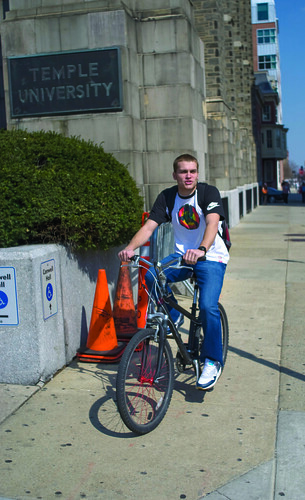
It’s your first morning biking to school and work. After three months of creeping fear and countless winter mornings of guilt-tainted glances at the sweet cruiser you bought on Craigslist, this is your moment of truth.
You step out on the curb, take a deep breath of sweet spring air, saddle up and hit the street. Passing your third, fourth and fifth blocks with relative ease, you’re amazed at how smoothly the traffic is moving.
“Say, this ain’t that bad. Not bad at all,” you say to yourself. After months of dread and deliberation, you smite yourself for being such a wuss.
Five minutes later, it’s “Good morning, Center City!”
There’s a double-parked beer truck ahead. Noted.
A SEPTA bus growls at your rear, and a jerk in a Hummer inches his way to your left. These sons of a…
The bike lane suddenly disintegrates, and out of the fog of traffic, a car door swings open. You’ve just been doored. Hello, Nurse.
It’s no great mystery that for many city dwellers, biking is the only way to travel. The Bicycle Coalition of Greater Philadelphia estimates that the city’s bicycle commuters make roughly 70,000 to 80,000 trips daily.
The perks of pedaling are seemingly endless. Say goodbye to shoveling 20 percent of your annual income into your car and selling your birthright to buy gas. And parking? Pfft, whatever.
For religious SEPTA riders, this means no more morning zone-out sessions with what looks to be blood streaming down the station walls of the Broad Street Line.
Unless you’re beefing up for the Highland games, you can cancel your gym membership. For every 40 minutes spent pedaling, bike commuters can burn anywhere between 250 and 300 calories, as much as you would shed doing low impact aerobics in the same amount of time.
Carbon footprint got you down? Don’t forget the environmental virtues of bike commuting. A quick four-mile round trip by bike keeps around 15 pounds of pollution out of the air, according to the World Watch Institute.
Yet, making the transition isn’t as simple as some will tell you. For first-time cyclists, going out ill-equipped and uneducated can be very dangerous and just plain stupid.
In the “city that loves you back,” the Pennsylvania Department of Transportation estimates that around 400 to 800 bicycle accidents are reported each year.
“One of the most common mistakes first-time riders make is thinking that automobiles, buses and taxis will give you room to ride,” said Russell Meddin, a community cycling advocate and contributing organizer of Bike Share Philadelphia. “They will not, even if you are in a bike lane.”
According to the Philadelphia Streets Department, the most common causes of bicycle-related accidents include riding against traffic (in either streets or bike lanes), riding on sidewalks, the absence of lights and reflectors, and confusion at intersections, typically when a cyclist is heading straight as an oncoming car is turning.
“Drivers do not always understand that a bicycle has the same right to use the road as a car,” Meddin said. “Also, keep aware of what is around you: front, back, left and right. And respect pedestrians. You are not allowed to ride a bicycle on the sidewalk if you are over 12 years old.”
Learning the tenor of the street can help you in the long run and might help you avoid certain life-threatening situations. Pick a route and stick with it for a week or two. The repetition will expose you to traffic patterns and drivers’ habits. Observe carefully and shadow other cyclists on your route.
Ultimately, the best ways to prevent an accident are to stay aware and stay focused. Keep the iPod out of your ears and your eyes on the road.
Michael Bixler can be reached at mmbixler@temple.edu.



Don’t forget the most common mistake made by those on the actual bikes-you are not exempt from the rules of the road. You are still supposed to stop at a red light. Looking left and right and then biking through can cause a collision that is the biker’s fault.
As for the “pounds of pollution out of the air”-becoming a vegetarian saves far more pollution than biking ever will.